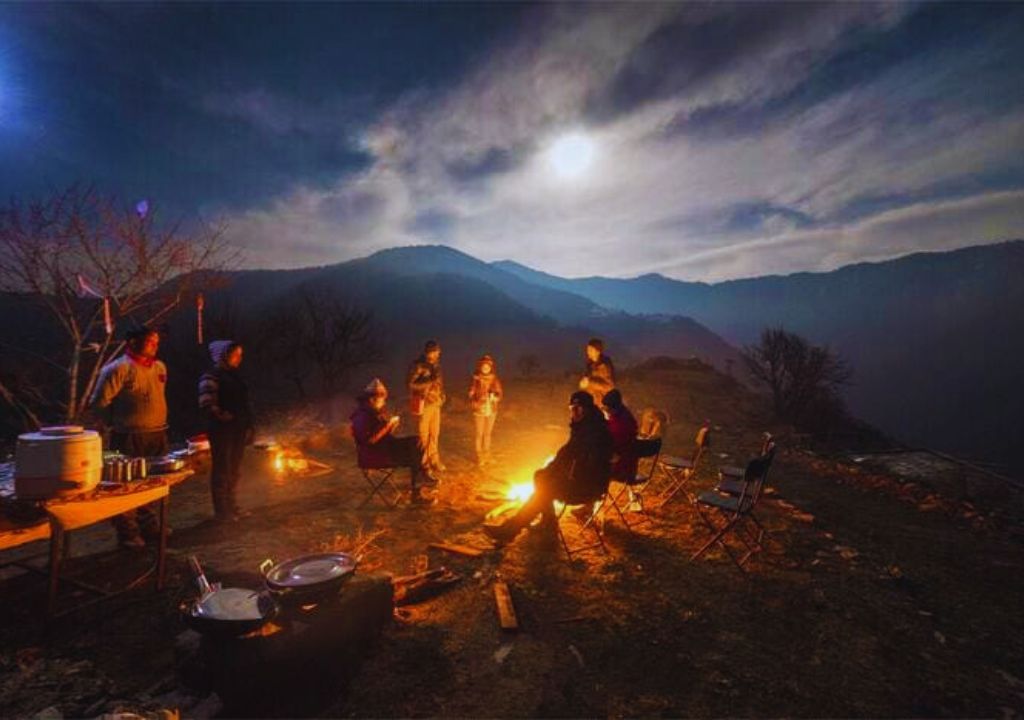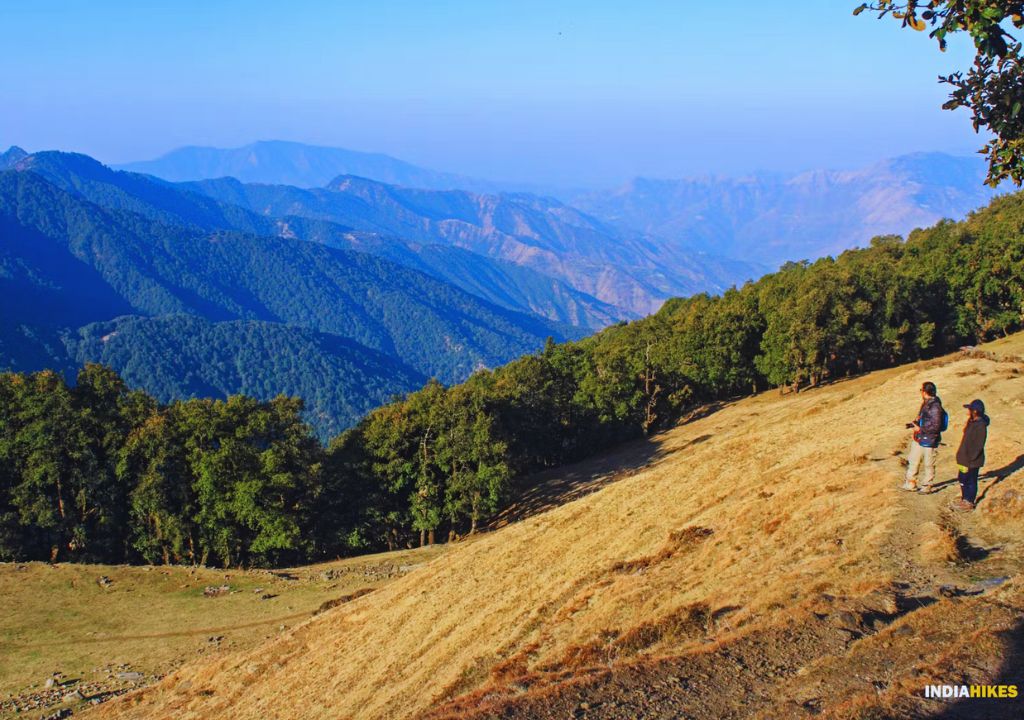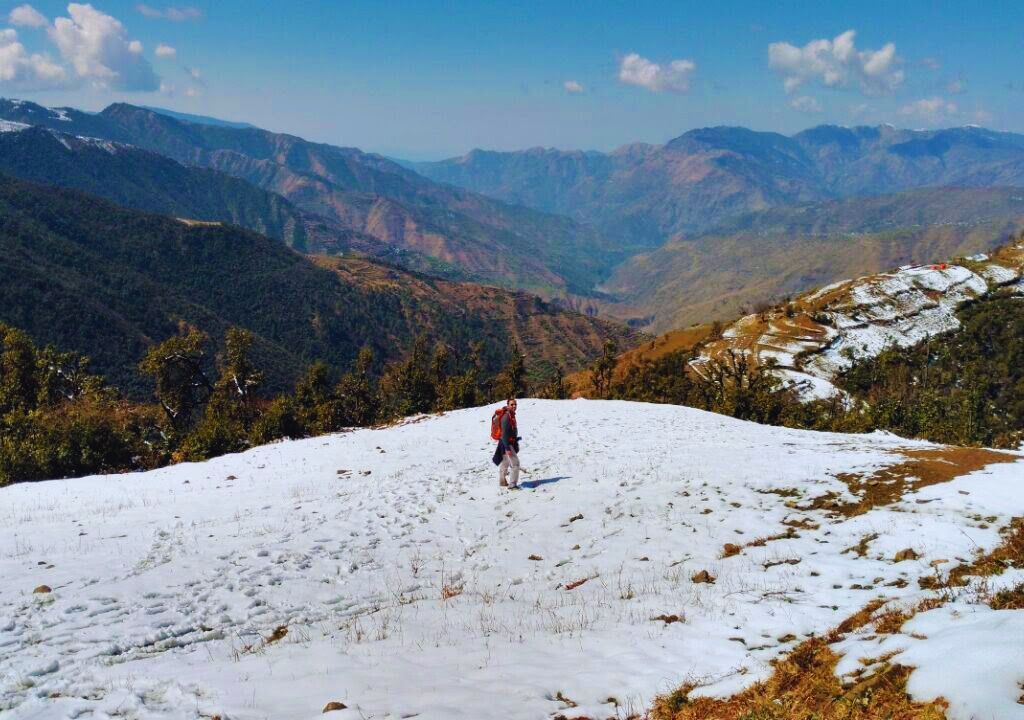Welcome to the Rajaji Jungle Safari blog post. Today we explore the Nag Tibba trek. It’s also called Serpents Peak, located in Garhwal near Mussoorie. Nag Tibba is the highest peak in the lower Himalayas. It’s perfect for both new and experienced trekkers. You’ll see amazing views of the Banderpunch ranges, the Great Indian Himalayas, and Chanabang’s snow peaks.
The Nag Tibba trek is good all year round. But the best times are April to June and October to December. This trek takes 2-3 days, perfect for a quick break from Delhi or Dehradun. There are many ways to the top, each showing you something special.
For staying, camping is the top choice with a few guesthouses available. The trek is safe as it’s near Mussoorie and Dehradun, without landslide or flood risks. It’s smart to bring your food. There are no food or tea places on the path. The trek is also special because of the Nag Tibba Temple, for the serpent god Nag Devta.

Nag Tibba Trekking Routes
Nag Tibba has three trekking routes for adventurers to pick from. Each one gives a different experience. You’ll see stunning views of the area’s landscapes on each route.
Devalsari Village Route
Begin your journey at Devalsari Village. It’s about 13 kilometers from the starting point. This trail takes you through a thick deodar forest. You’ll see the grandeur of the Himalayas clearly. The area is full of greenery and stands out for its calmness. This makes the trek a truly mesmerizing experience.
Panthwari Village Route
The trek from Panthwari Village is very popular. It’s a bit shorter, around 8 kilometers. You will need a guide to help you find your way. This route treats you to amazing views of the Himalayan peaks. You’ll also enjoy the beautiful surroundings around Nag Tibba.
Aunter Route
The third route starts at Aunter. You can reach Aunter by car via Thatyur. From there, you’ll hike to the ridge and then follow a mostly level path. This route is special because it lets you be in nature’s quiet and see wide mountain views.
Choose the Devalsari, Panthwari, or Aunter route — they all have something special to offer. No matter which path you take, the Nag Tibba trek is an adventure you won’t forget.

Nag Tibba Trek Itinerary
Here’s a day-by-day plan for the Nag Tibba trek:
Day 1: Drive from Dehradun to Pantwari village and trek to Camp 1
Begin early in Dehradun and head to Pantwari village. The drive uphill takes about 4 hours. Enjoy lunch at the village. Then, kick off the trek to Camp 1, a cozy spot in the forest. Pitch your tent and enjoy the wilderness under the stars.
Nag Tibba Trekking Tips and Safety Measures
For a safe and fun Nag Tibba trek, keep these tips in mind:
1. Carry Essential Supplies
Bring enough water and food because food stops are rare. Also, have the right trekking gear. This means strong shoes, warm clothes, a raincoat, and a first-aid kit.
2. Trek with Experienced Guides
Trek with a local guide or a group who knows the area well. They can keep you safe and share helpful tips along the route.
3. Check Weather Conditions
Before you start, check the weather. Be ready for any weather change, like sudden cold, rain, or snow. Pack what you need to stay safe and cozy.
4. Respect Local Traditions
Be mindful of local customs and cultures. Follow local advice, like not eating meat on the trek, to show respect and cultural awareness.
5. Inform Someone About Your Plans
Tell a friend or family about your trek plans. Share your route and an emergency contact. This way, help can find you if there’s a need.

6. Follow the Marked Trail
Stick to the official trail. Always obey your guide’s or leader’s directions. Avoiding unmarked paths will keep you safe and on the right track.
7. Consider Your Physical Fitness
Know your limits before the trek starts. It’s okay to rest and drink water when you need to. Don’t overdo it and listen to what your body tells you.
8. Be Aware of Altitude Sickness
Be on the lookout for altitude sickness. Symptoms are dizziness, headache, nausea, and tiredness. Stay hydrated and if you feel sick, descend.
9. Carry Necessary Permits and Identification
Get the required permits in advance. Also, carry an ID like your passport. These are needed during the trek.
By remembering and following these tips, you’ll find Nag Tibba a great experience. Have a safe journey to its stunning summit.

Nag Tibba Trek Accommodation Options
Accommodation for the Nag Tibba trek is mostly camping. You can camp at places like Camp 1 and Nag Tibba Base Camp. Bring your camping gear, like tents and sleeping bags. If camping isn’t your thing, a Forest Rest House is available at Nag Tibba’s base camp. You can book it through the Mussoorie Forest Office. Also, there are budget guesthouses at Devalsari or Pantwari.
When deciding where to stay, remember to book early, especially during busy times.
Best Time to Do Nag Tibba Trek
The Nag Tibba trek is full of stunning views and exciting for adventurers. Picking the right time to go is key for an amazing trip.
The best times for the Nag Tibba trek are February to mid-June and mid-September to the end of November. These months have the best weather and let you see beautiful landscapes.
From April to June, the weather is nice, with temperatures from 8 to 25 degrees Celsius. It’s perfect for those who like mild weather and easy hiking.
However, from October to December, you can experience snow trekking. It’s a chance to see snow, making Nag Tibba look like a winter wonderland.
Make sure to check the weather before you go. Dress in layers, and bring warm clothes, and the right gear for a safe and comfy trek.
Avoid trekking from July to September because it’s monsoon season. The trails might get slippery, and landslides could be dangerous.

Essential Considerations for Trekking
- Check the weather forecast before starting the trek.
- Ensure proper clothing and gear are packed based on the expected weather conditions.
- Carry sufficient food, water, and medical supplies for the duration of the trek.
- Travel with a trained guide or as part of an organized group to ensure safety.
- Respect and follow local guidelines and traditions to preserve the environment.
- Be mindful of personal fitness and take breaks as needed.
- Stay hydrated and be aware of the symptoms of altitude sickness.
Picking the right time and preparing properly lets trekkers enjoy the Nag Tibba trek fully. It ensures memories that last a lifetime.
| Best Time to Do Nag Tibba Trek | Advantages | Disadvantages |
|---|---|---|
| February to mid-June | Pleasant weather, clear views, moderate temperatures | Higher chances of encountering other trekkers |
| Mid-September to end-November | Optimal weather conditions, clear views, less crowded | Cooler temperatures, chance of encountering snow in November |
| July to September (Monsoon) | Lush greenery, fewer trekkers | Slippery trails, risk of landslides, limited visibility |
| October to December (Winter) | Cooler temperatures, a chance of encountering snow in November | Cold temperatures, increased difficulty in navigation |

Nag Tibba Trek Difficulty Level
The Nag Tibba trek is a good starting point for both beginners and those with some experience. It has a steady climb and some ups and downs that won’t tire you out. Although there are steep parts, walking carefully and using the right equipment can help you tackle them.
The trek is around 16 kilometers long. Usually, people take 2-3 days to finish it. The path is easy to follow, but during winter, snow can make it hard to see the way. In winter, having a local guide or trekking with experienced friends is a good idea for safety.
This trek doesn’t take you too high up. The highest point, Nag Tibba summit, is about 9,900 feet above sea level. So, it’s great for those not used to high altitudes yet. But, being in good shape is important. It’s smart to work out and get fit before you go. This can help make the trek easier on your body.
To wrap up, the Nag Tibba trek is both challenging and rewarding. It showcases stunning views and has a clear path. Just make sure you’re in good physical shape and have the right equipment. Then, no matter your skill level, you’ll have a great time in the breathtaking Himalayas.
Nag Tibba Trek Cost and Booking Information
The Nag Tibba trek is a chance to see the beautiful Garhwal region near Mussoorie. To plan this adventure well, it’s key to know about the costs and how to book. This ensures you have a great trip.
Costs for the Nag Tibba trek can change based on a few things. These things are how many people are in your group, how long you’ll trek, and what’s included. Many tour operators and agencies have packages for every budget.
Starting from Rs. 2,000, these packages cover lodging, food, rides, permits, and a guide. Choosing a package means everything is set, so you just enjoy the journey.

Booking early for the Nag Tibba trek, especially during busy times, is smart. It secures your place and stops any rush at the end. It also lets you look around to see who offers the best deals that match your wants and wallet.
Some operators can make a special Nag Tibba trek just for you. These are made to fit how fit you are, what you like, and how much time you have. It makes the adventure perfect for you.
Picking a respected and skilled tour operator is vital when booking your Nag Tibba trek. You want someone who’s known for great trips and top service. Checking what others say in reviews and stories helps a lot.
Booking Tips for Nag Tibba Trek
- Start your booking process well in advance to secure your spot.
- Compare prices and services offered by different tour operators.
- Check the inclusions and exclusions of the trekking package.
- Consider the reputation and experience of the tour operator.
- Read reviews and testimonials from previous trekkers.
- Ensure that the tour operator has the necessary permits for conducting the trek.
By sticking to these tips and getting a good handle on the costs and bookings, you’ll be all set for the Nag Tibba trek. Get ready for an amazing journey in the stunning Himalayas.

Nag Tibba Trekking Experience and Reviews
The Nag Tibba trek in the Himalayas is truly memorable. You’ll see stunning mountain views and experience untouched nature. It takes you through dense forests full of plants and animals.
Many trekkers love the beautiful landscapes and clear, easy-to-follow paths. They also praise the locals for their warmth. Hitting the Nag Tibba summit is a big achievement. It leaves you feeling really fulfilled.
Camping under the night sky is a major part of this trek. The quiet creates a peaceful atmosphere. It helps you forget about the busy life back home.
Reading about others’ experiences can also prepare you for your own. Reviews from other hikers tell their stories. They give you a good idea of what to expect. Nag Tibba is the place for an amazing Himalayan trek. It will make you want to come back for more.
FAQs About Nag Tibba Trek
What is the Nag Tibba Trek?
The Nag Tibba Trek is also known as Serpents Peak. It’s the highest peak in the lower Himalayas, located near Mussoorie. This trek is loved for its beautiful scenery and is great for various skill levels.
What are the trekking routes to reach the summit of Nag Tibba?
To reach Nag Tibba’s summit, you can take three routes. These are the Devalsari Village, Panthwari Village, and Aunter routes.
What is the recommended itinerary for the Nag Tibba trek?
The best Nag Tibba trek plan starts with a drive from Dehradun to Pantwari village. Then, trek to Camp 1 and stay overnight at the campsite.
What are some tips and safety measures for the Nag Tibba trek?
For the Nag Tibba trek, it’s crucial to have enough water and food. Wear the right clothes, and bring trekking gear. Also, consider hiring a guide, check the weather, and respect the local customs.
What are the accommodation options for the Nag Tibba trek?
There are limited places to stay on the Nag Tibba trek. Most people camp. Or, you can find rooms at the Forest Rest House, or in budget guesthouses at Devalsari or Pantwari.
What is the best time to do the Nag Tibba trek?
The best times for the Nag Tibba trek are from February to mid-June and mid-September to the end of November. During these times, the weather is good, and you can see far.
What is the difficulty level of the Nag Tibba trek?
The Nag Tibba trek is quite easy, fitting for both new and seasoned trekkers. It has some uphill parts and a few steep slopes.
How much does the Nag Tibba trek cost and how can I book it?
The trek’s cost varies based on factors like group size and trek length. It’s wise to compare costs and services from different organizers before booking.
What is the trekking experience like and what are the reviews of the Nag Tibba trek?
The Nag Tibba trek offers a special Himalayan experience. Reviews often mention the breathtaking views, achieving the summit, and the calm atmosphere. It’s good to read several reviews for a full picture.

